


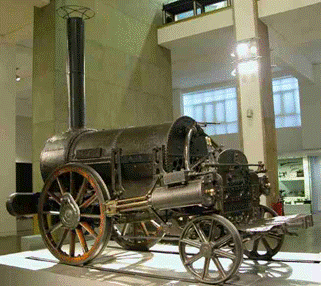
Stephenson's Engine
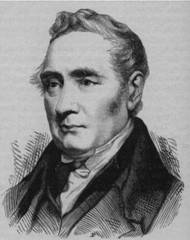 George Stephenson was born in Wylam, Britain, on June 9th, 1781. Stephenson was a cow herder until he became employed at the Dewley Colliery (coal mine and refinery) at age fourteen. Four years later he began attending night classes to learn to read and write, which allowed him to become a colliery engineman at age twenty-one. In 1808, Stephenson moved to Killingworth Colliery, where he began his hobby of taking apart engines so that he could rebuild them to better understand how they worked. In 1813, Stephenson learned that William Hedley and Timothy Hackworth (both employees of Dewley Colliery) were trying to develop a locomotive. Stephenson was able to convince his colliery manager of the benefits of a locomotive and received permission to try to produce a steam-powered machine. One year later in 1814, Stephenson had successfully created a loco-motive he called The Blutcher. The Blutcher could pull a load of thirty tons up a hill at four miles-per-hour. The owners of Killingworth Colliery were so impressed with Stephenson's success that they gave him the job of constructing an eight-mile railroad. Stephenson used his steam-powered engine and gravity to make this track the first railway completely independent of animal power. Four years later, Stephenson joined with Edward Pease, Michael Longdridge, and his own son Robert Stephenson to form Robert Stephenson & Company, the first industry that produced locomotives. Stephenson continued to develop his engine until is death on August 12th, 1848. He is credited with developing the first steam-powered engine and locomotive.
George Stephenson was born in Wylam, Britain, on June 9th, 1781. Stephenson was a cow herder until he became employed at the Dewley Colliery (coal mine and refinery) at age fourteen. Four years later he began attending night classes to learn to read and write, which allowed him to become a colliery engineman at age twenty-one. In 1808, Stephenson moved to Killingworth Colliery, where he began his hobby of taking apart engines so that he could rebuild them to better understand how they worked. In 1813, Stephenson learned that William Hedley and Timothy Hackworth (both employees of Dewley Colliery) were trying to develop a locomotive. Stephenson was able to convince his colliery manager of the benefits of a locomotive and received permission to try to produce a steam-powered machine. One year later in 1814, Stephenson had successfully created a loco-motive he called The Blutcher. The Blutcher could pull a load of thirty tons up a hill at four miles-per-hour. The owners of Killingworth Colliery were so impressed with Stephenson's success that they gave him the job of constructing an eight-mile railroad. Stephenson used his steam-powered engine and gravity to make this track the first railway completely independent of animal power. Four years later, Stephenson joined with Edward Pease, Michael Longdridge, and his own son Robert Stephenson to form Robert Stephenson & Company, the first industry that produced locomotives. Stephenson continued to develop his engine until is death on August 12th, 1848. He is credited with developing the first steam-powered engine and locomotive.
Picture Sources:
Engine: http://www.solarnavigator.net
Portrait: http://www.gutenberg.org
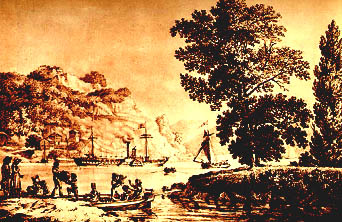
The Clermont
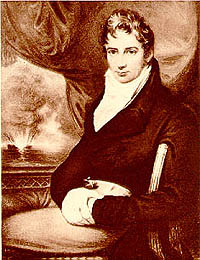 Robert Fulton was born on November 14, 1765 in Lancaster County, Pennsylvania. Fulton's true ambition was to become a painter, which he attempted to follow by moving to Paris when he turned twenty-one in 1786. His works weren't successful and Fulton turned to inventing. His design for a submarine caught the attention of the American Ambassador, Robert Livingston. Livingston brought Fulton back to the United States and had him focus on creating a design for a steamboat. Fulton ordered an engine from England and attached it to a hull and paddles. The result was a very basic steamboat the Fulton called The Clermont. The Clermont was first tested in 1807 on the Hudson River, where it failed. But after Fulton adjusted the engine it was able to make a thirty-two hour journey to Albany at an average speed of five mile-per-hour. Fulton patented his design on February 11th, 1089. Livingston and Fulton then became co-owners of a steamboat service that ran on rivers from New York to New Orleans. Robert Fulton died on February 24th, 1815 in New York. He is credited with designing and building the first steamboat and co-founding the first steamboat service.
Robert Fulton was born on November 14, 1765 in Lancaster County, Pennsylvania. Fulton's true ambition was to become a painter, which he attempted to follow by moving to Paris when he turned twenty-one in 1786. His works weren't successful and Fulton turned to inventing. His design for a submarine caught the attention of the American Ambassador, Robert Livingston. Livingston brought Fulton back to the United States and had him focus on creating a design for a steamboat. Fulton ordered an engine from England and attached it to a hull and paddles. The result was a very basic steamboat the Fulton called The Clermont. The Clermont was first tested in 1807 on the Hudson River, where it failed. But after Fulton adjusted the engine it was able to make a thirty-two hour journey to Albany at an average speed of five mile-per-hour. Fulton patented his design on February 11th, 1089. Livingston and Fulton then became co-owners of a steamboat service that ran on rivers from New York to New Orleans. Robert Fulton died on February 24th, 1815 in New York. He is credited with designing and building the first steamboat and co-founding the first steamboat service.
Picture Sources:
The Clermont: http://xroads.virginia.edu/~HYPER/DETOC/transport/fulton.html
Portrait: http://xroads.virginia.edu/~HYPER/DETOC/transport/fulton.html
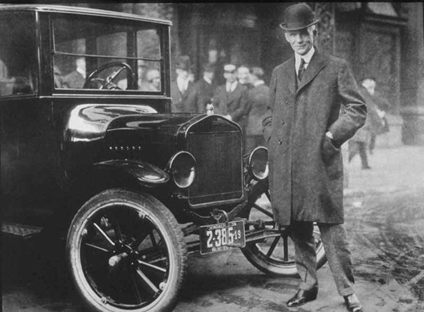
The Model T
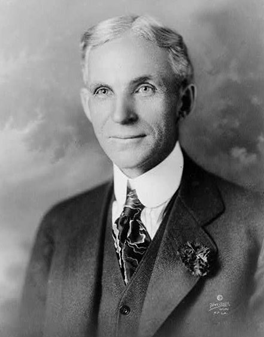 Henry Ford was born on July 30, 1863 in Dearborn Michigan. From an early age, Ford showed an interest in machinery. He left the farm for Detroit at age sixteen in 1879 to become an apprentice mechanic. He returned three years later and became a steam-engine repairer.? Fourteen years later in 1891 Ford became an employee of the Edison Illuminating Company, a company that promoted him to Chief Engineer to years later in 1893. This new position gave him the resources to continue his experiments on internal combustion engines. His first success was the Quadricycle in 1896. The Quadricycle was basically four wheels with an engine that had two speeds, but no reverse setting. After this success, Ford tried to establish a company that would be dedicated to producing reliable automobiles. He would fail twice before establishing the Ford Motor Company in 1903. His company hit big with the Model T in 1808. It immediately became a huge success as it was easy to operate and maintain, and was sturdy enough for rough roads. Ten years later in 1818, half the cars on American roads were Model T?s. To meet demands, Ford opened a factory in Highland Park, Michigan. It was here that in 1913 Ford famously utilized the assembly line. Because of the efficiency of the assembly line, the price of the Model T could be lowered so that the majority of American families could enjoy an automobile. Henry Ford died of a cerebral hemorrhage at the age of eighty-three in 1947. He is credited with the creation of the first efficient and affordable automobile, the Model T. And in credit to his memory, one of his more famous quotes is listed below.
Henry Ford was born on July 30, 1863 in Dearborn Michigan. From an early age, Ford showed an interest in machinery. He left the farm for Detroit at age sixteen in 1879 to become an apprentice mechanic. He returned three years later and became a steam-engine repairer.? Fourteen years later in 1891 Ford became an employee of the Edison Illuminating Company, a company that promoted him to Chief Engineer to years later in 1893. This new position gave him the resources to continue his experiments on internal combustion engines. His first success was the Quadricycle in 1896. The Quadricycle was basically four wheels with an engine that had two speeds, but no reverse setting. After this success, Ford tried to establish a company that would be dedicated to producing reliable automobiles. He would fail twice before establishing the Ford Motor Company in 1903. His company hit big with the Model T in 1808. It immediately became a huge success as it was easy to operate and maintain, and was sturdy enough for rough roads. Ten years later in 1818, half the cars on American roads were Model T?s. To meet demands, Ford opened a factory in Highland Park, Michigan. It was here that in 1913 Ford famously utilized the assembly line. Because of the efficiency of the assembly line, the price of the Model T could be lowered so that the majority of American families could enjoy an automobile. Henry Ford died of a cerebral hemorrhage at the age of eighty-three in 1947. He is credited with the creation of the first efficient and affordable automobile, the Model T. And in credit to his memory, one of his more famous quotes is listed below.
"History is more or less bunk" - Henry Ford, Chicago Tribune, May 25th, 1916
www.dictionary.com:
bunk: n, [bungk]
1. humbug
2. a trough for feeding cattle
He said it Mr. Barton, not us.
Picture Sources:
Model T: http://www.shadetreemechanic.com/ford_centennial_in_atlanta.htm
Portrait: http://www.americaslibrary.gov/jb/civil/jb_civil_ford_1_e.html
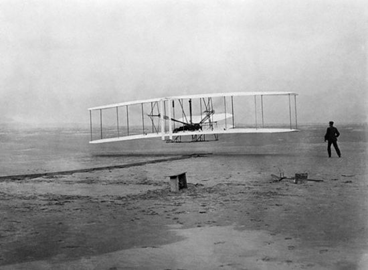
The Wright Flyer
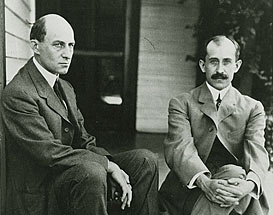 Orville and Wilbur Wright, born in 1871 and 1867 respectively, were two of five children in their family, which moved frequently due to the various jobs of the father Bishop Wright. As a result of a hockey accident in 1885 or 1886 in which he was struck in the face, Wilbur abandoned his plan of going to Yale and instead remained with Orville, caring for their mother. Orville began a printing business in 1889 with Wilbur�s help, and the two then began the Wright Cycle Company, a bicycle repair and sales shop, in 1892. They used this business to fund their interest in flight, and eventually moved to Kitty Hawk, North Carolina in 1900 to carry out their gliding experiments because of the ideal flying weather which Kitty Hawk had. Their first full-sized glider was a biplane hang glider which initially flew as a kite, with men on the ground holding ropes connected to the plane. Orville and Wilbur carried out hundreds of tests over the next three years, and at one point Wilbur believed that man would not fly in their lifetime. However, then in 1903 the built the Wright Flyer, with their own hand-carved wooden propellers and a gasoline engine built in their bicycle shop. On December 17, 1903, the brothers flew their plane about ten feet above the ground for four short flights which lasted only about twelve seconds. However high winds wrecked this plane and, over the next several years, the Wright Brothers continued to build new planes and carry out further experiments and were eventually able to obtain a patent after a long struggle. Wilbur died of typhoid fever in 1912 and Orville died in 1948 as the result of a heart-attack.
Orville and Wilbur Wright, born in 1871 and 1867 respectively, were two of five children in their family, which moved frequently due to the various jobs of the father Bishop Wright. As a result of a hockey accident in 1885 or 1886 in which he was struck in the face, Wilbur abandoned his plan of going to Yale and instead remained with Orville, caring for their mother. Orville began a printing business in 1889 with Wilbur�s help, and the two then began the Wright Cycle Company, a bicycle repair and sales shop, in 1892. They used this business to fund their interest in flight, and eventually moved to Kitty Hawk, North Carolina in 1900 to carry out their gliding experiments because of the ideal flying weather which Kitty Hawk had. Their first full-sized glider was a biplane hang glider which initially flew as a kite, with men on the ground holding ropes connected to the plane. Orville and Wilbur carried out hundreds of tests over the next three years, and at one point Wilbur believed that man would not fly in their lifetime. However, then in 1903 the built the Wright Flyer, with their own hand-carved wooden propellers and a gasoline engine built in their bicycle shop. On December 17, 1903, the brothers flew their plane about ten feet above the ground for four short flights which lasted only about twelve seconds. However high winds wrecked this plane and, over the next several years, the Wright Brothers continued to build new planes and carry out further experiments and were eventually able to obtain a patent after a long struggle. Wilbur died of typhoid fever in 1912 and Orville died in 1948 as the result of a heart-attack.
Picture Sources:
The Wright Flyer: www.nasaexplores.com/show2_articlea.php?id=03-018
Portrait: www.pbs.org/wgbh/nova/wright/reporter.html